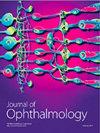Anatomical and functional outcomes of idiopathic macular hole surgery with fovea-sparing versus conventional internal limiting membrane peeling
IF 1.8
4区 医学
Q3 OPHTHALMOLOGY
引用次数: 0
Abstract
Purpose: To compare fovea-sparing and conventional internal limiting membrane (ILM) peeling in idiopathic macular hole (IMH) surgery in terms of IMH closure type, hole closure incidence and visual outcome. Material and Methods: The ILM was peeled around the IMH in the conventional ILM peeling group. In the fovea-sparing ILM peeling group, an ILM flap was created temporally to the IMH (with an ILM remnant left attached to the margins of the IMH), folded over the hole and stabilized with viscoelastic. Gas tamponade with 20% SF6 or 15% С3F8 was used. In the postoperative period, IMH closure pattern was assessed. Thicknesses of the outer retinal layers, inner retinal layers and retinal nerve fiber layer in the macular region were measured at 1 and 3 months. Results: Totally, 70 patients (15 males and 55 females) had an IMH surgery in 71 eyes. The mean age (SD) was 65.7 (6.8) years. The median IMH duration (interquartile range (IQR)) was 3.0 (1.0-6.0) months, and the mean preoperative BCVA (standard deviation (SD)), 0.19 (0.16). Thirty-four eyes had an IMH surgery with conventional ILM peeling, and 37 eyes, an IMH surgery with fovea-sparing ILM peeling. The two groups were matched in terms of preoperative visual acuity and macular hole duration. IMH closure was achieved in 30/34 eyes (88.2%) in the conventional ILM peeling group and 33/37 eyes (89.2%) in the fovea-sparing ILM peeling group. Particularly, IMH closure was achieved in 13/17 eyes that received gas tamponade with 20% SF6 and 20/20 eyes that received that with 15% С3F8 in the latter group. The rate of correct IMH closure pattern was substantially higher (64% versus 47%) and median postoperative BCVA (IQR), significantly better (0.55 (0.35-0.7) versus 0.43 (0.35-0.6), р = 0.039) in the fovea-sparing ILM peeling group than in the conventional ILM peeling group. An analysis of variance found a significant effect of the type of IMH surgery and IMH closure pattern on the postoperative BCVA (F1 = 5.06, p = 0.027; F2 = 7.9, p = 0.0001). In both groups, we found a significant thinning of the total retinal thickness in the central 1-mm foveal zone at 3 months compared to 1 month after surgery. There was a significant thinning of the outer and inner retinal layers in the conventional ILM peeling group, and no significant thickness changes in the retinal layers in the fovea-sparing group. Conclusion: Our fovea-sparing ILM peeling technique is an effective treatment option for IMHs, and when used with gas tamponade with 15% С3F8, enabled a primary surgery IMH closure rate of 100%.特发性黄斑孔手术保留中央凹与常规内限制膜剥离的解剖和功能结果
目的:比较特发性黄斑裂孔(IMH)手术中保留中央窝与常规内限制膜(ILM)剥离在IMH闭合类型、闭孔发生率和视力结果方面的差异。材料与方法:常规ILM剥离组在IMH周围剥离ILM。在保留中央窝的ILM剥离组,在IMH上暂时创建一个ILM皮瓣(ILM残余附着在IMH边缘),折叠在孔上并用粘弹性稳定。采用20% SF6或15% С3F8气体填塞。术后评估IMH闭合模式。分别于1、3个月测定黄斑区视网膜外层、视网膜内层及视网膜神经纤维层厚度。结果:70例患者(男15例,女55例)共71眼行IMH手术。平均年龄(SD) 65.7(6.8)岁。中位IMH持续时间(四分位间距(IQR))为3.0(1.0-6.0)个月,平均术前BCVA(标准差(SD))为0.19(0.16)。34只眼进行了常规的眼球内膜剥离手术,37只眼进行了保留中央凹的眼球内膜剥离手术。两组术前视力和黄斑孔持续时间相匹配。常规ILM剥离组有30/34只眼(88.2%)达到IMH闭合,保留中央凹ILM剥离组有33/37只眼(89.2%)达到IMH闭合。尤其值得一提的是,接受20% SF6气体填塞的13/17只眼和接受15% С3F8气体填塞的20/20只眼均实现了IMH闭合。保留中央窝的ILM剥离组IMH闭合模式的正确率(64%比47%)和术后中位BCVA (IQR)显著高于常规ILM剥离组(0.55(0.35-0.7)比0.43 (0.35-0.6),r = 0.039)。方差分析发现,IMH手术类型和IMH闭合方式对术后BCVA有显著影响(F1 = 5.06, p = 0.027;F2 = 7.9, p = 0.0001)。在两组中,我们发现与术后1个月相比,3个月时中央1毫米中央凹区的视网膜总厚度明显变薄。常规ILM剥离组视网膜外层和内层明显变薄,保留中央凹组视网膜层厚度无明显变化。结论:我们的保留中央窝的ILM剥离技术是治疗IMH的有效选择,当与15% С3F8气体填塞一起使用时,使初级手术IMH闭合率达到100%。
本文章由计算机程序翻译,如有差异,请以英文原文为准。
求助全文
约1分钟内获得全文
求助全文
来源期刊

Journal of Ophthalmology
MEDICINE, RESEARCH & EXPERIMENTAL-OPHTHALMOLOGY
CiteScore
4.30
自引率
5.30%
发文量
194
审稿时长
6-12 weeks
期刊介绍:
Journal of Ophthalmology is a peer-reviewed, Open Access journal that publishes original research articles, review articles, and clinical studies related to the anatomy, physiology and diseases of the eye. Submissions should focus on new diagnostic and surgical techniques, instrument and therapy updates, as well as clinical trials and research findings.
 求助内容:
求助内容: 应助结果提醒方式:
应助结果提醒方式:


